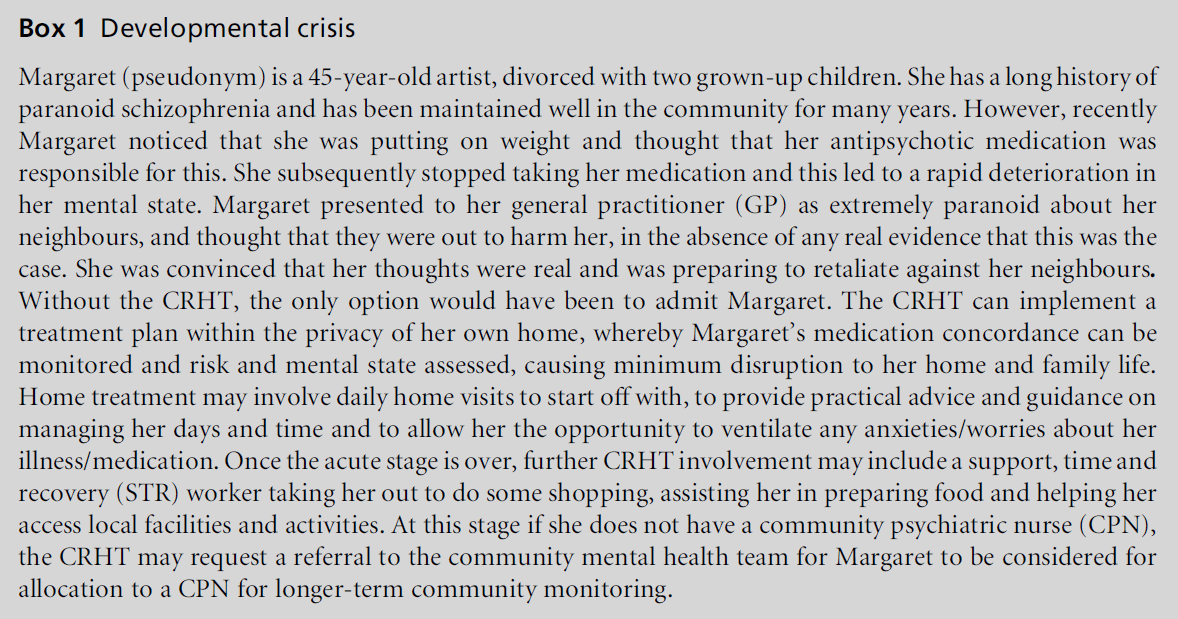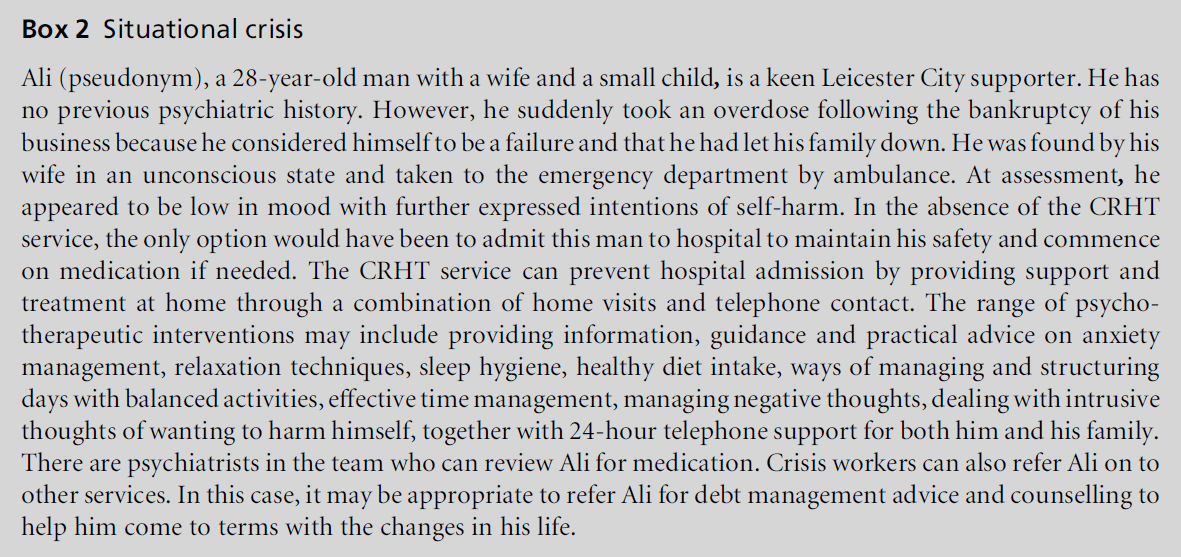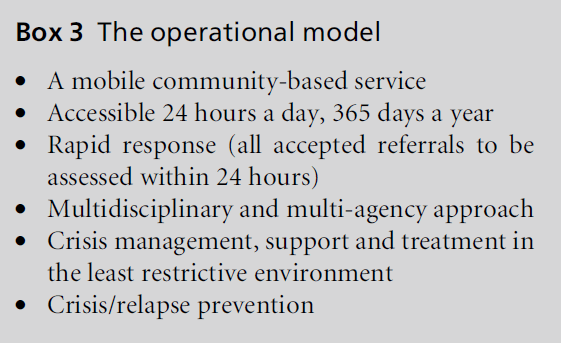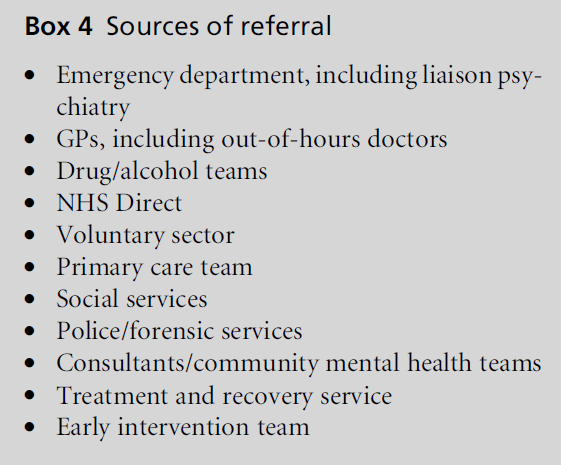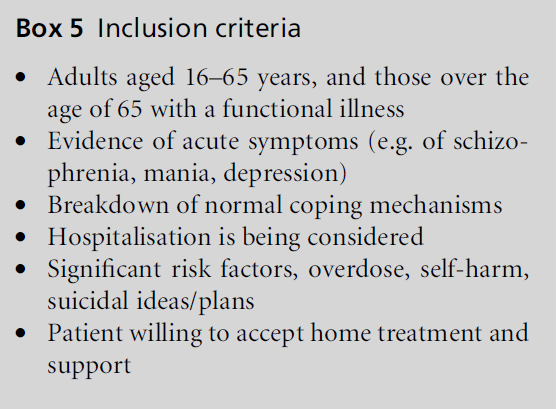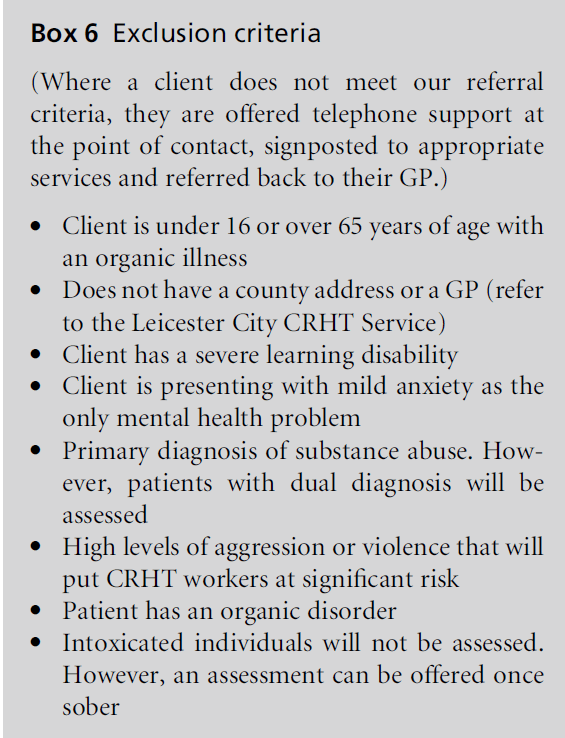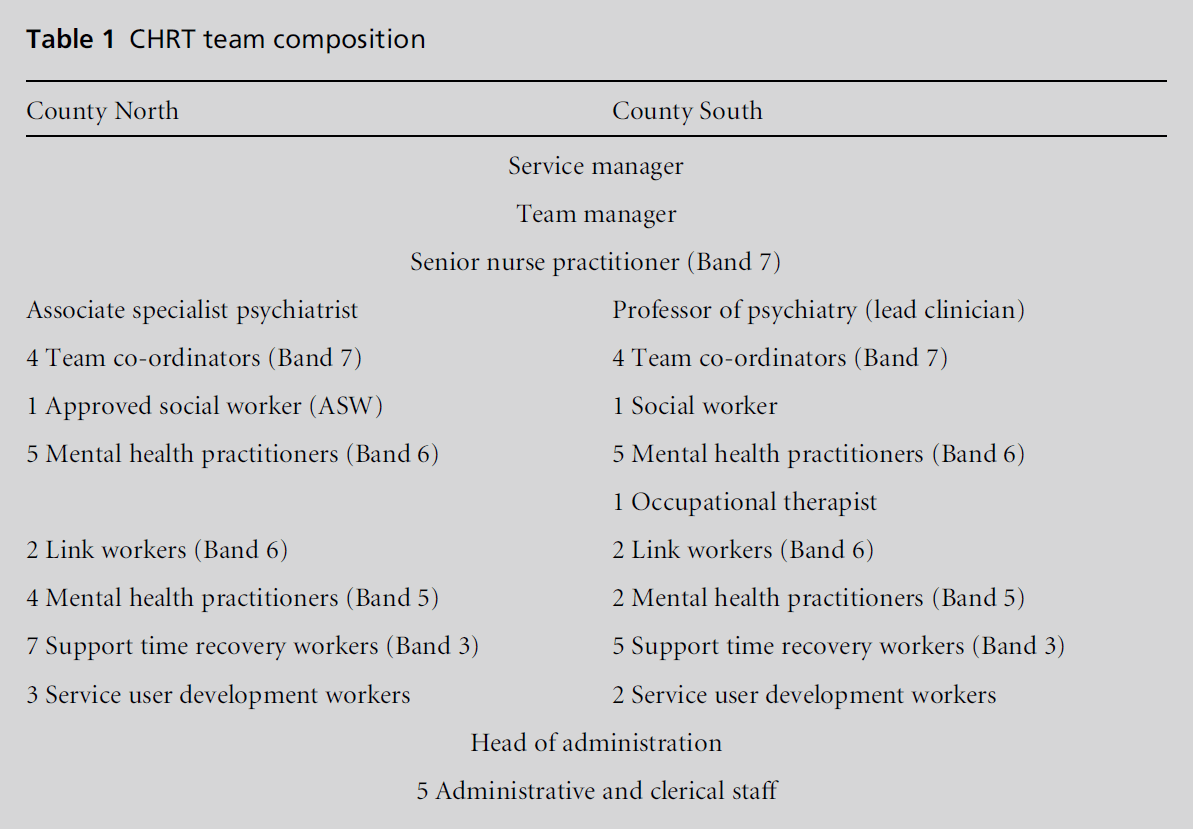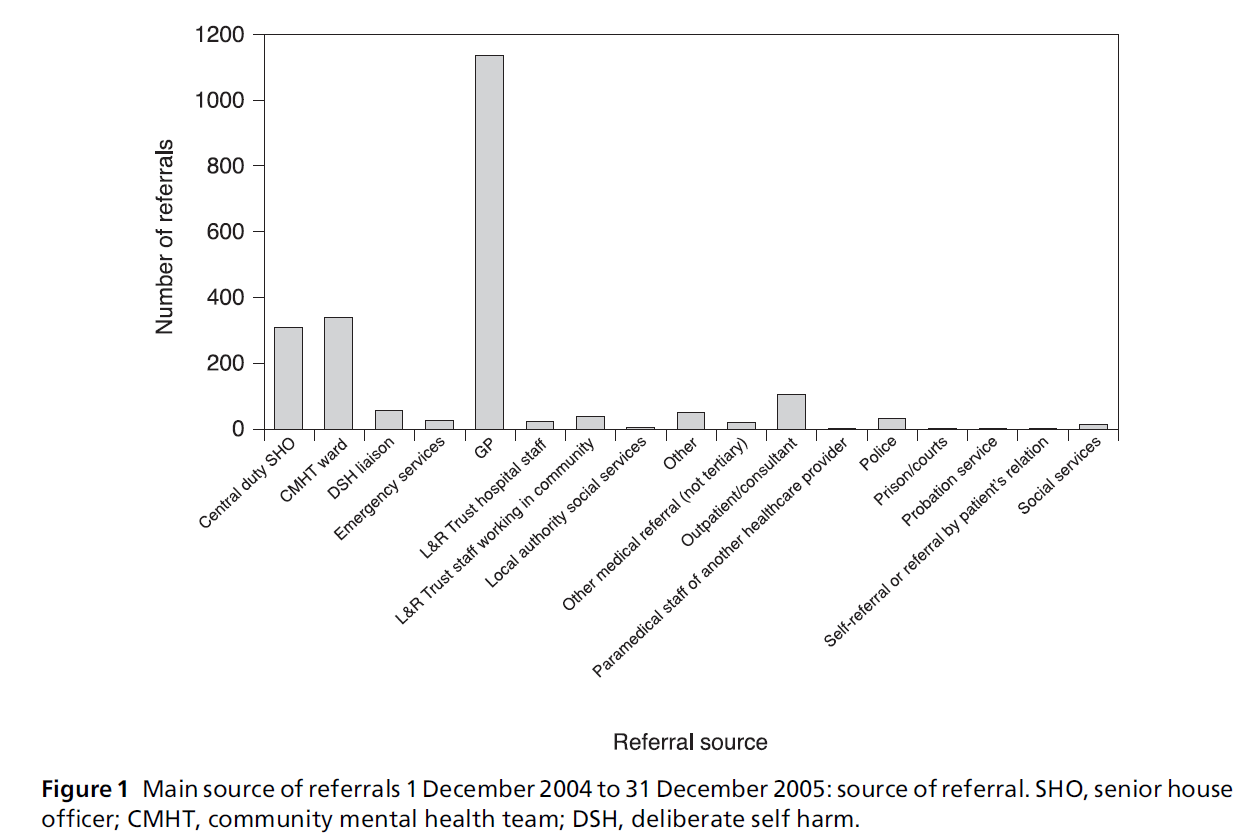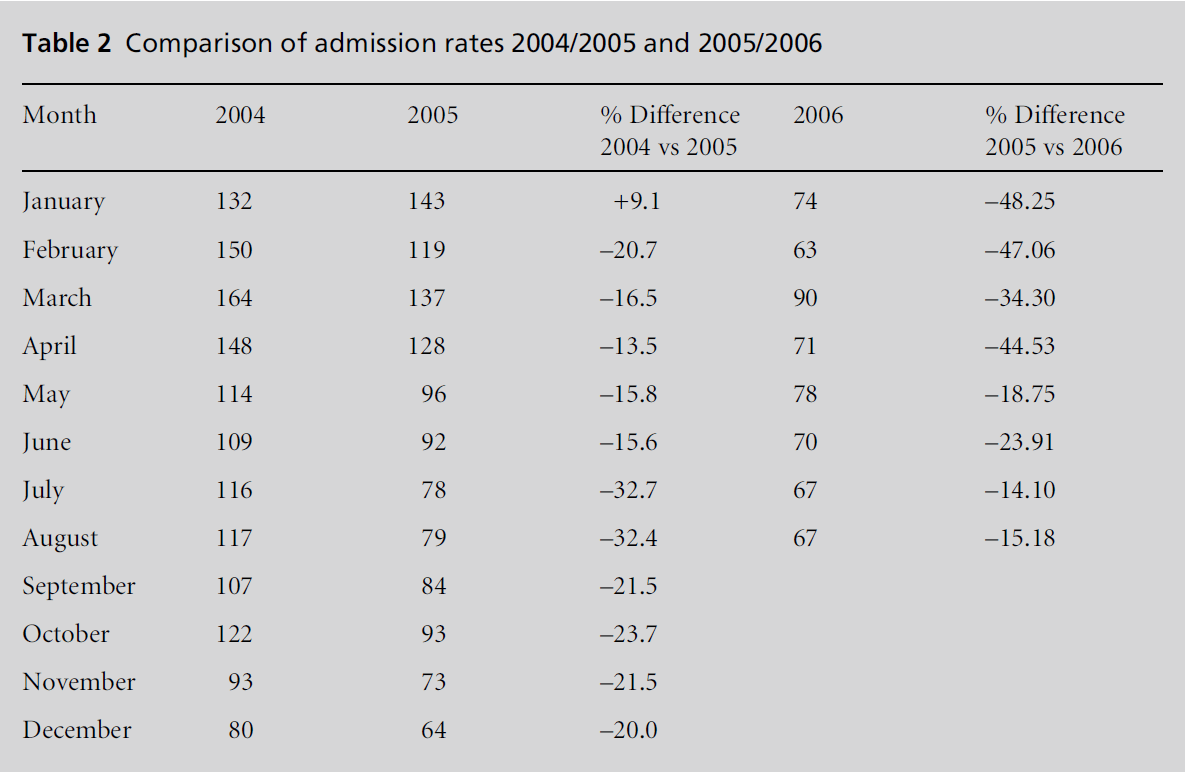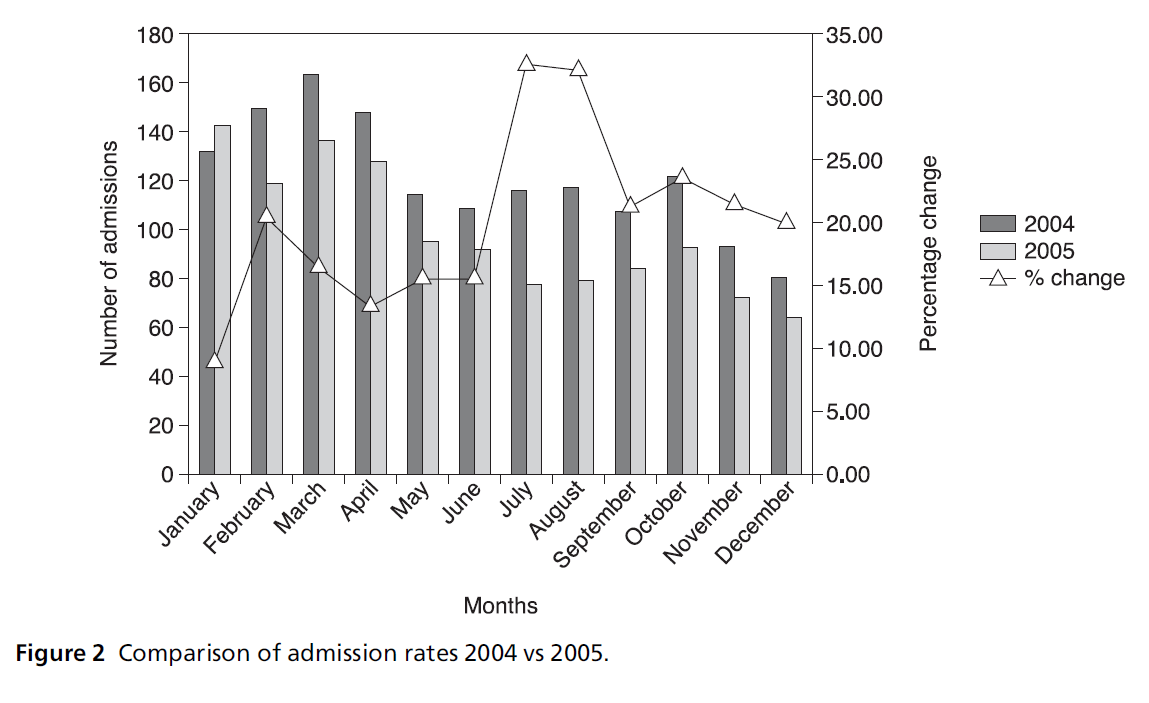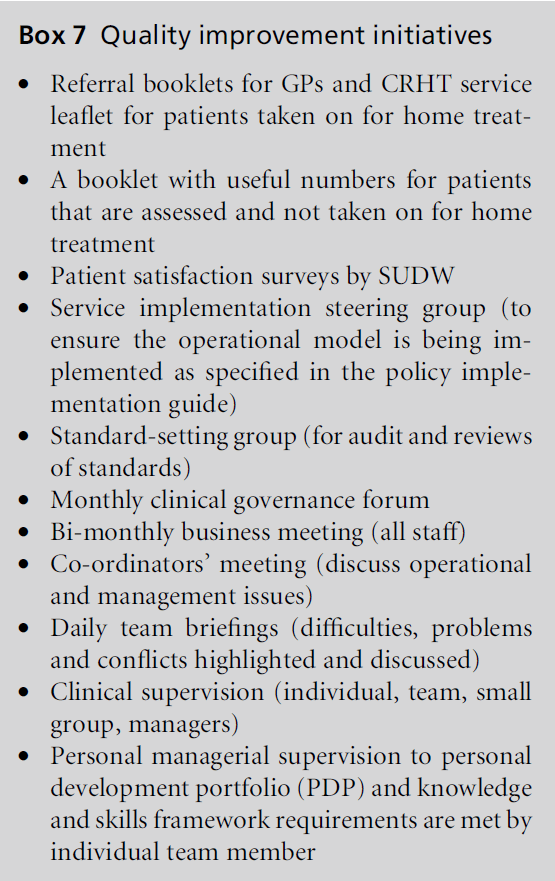Key words
adult mental health, community care,
crisis, crisis resolution, home treatment, rapid
response
Introduction
The National Service Framework (NSF) for Mental
Health (Department ofHealth, 1999) established various
standards for mental healthcare provision. These included
mental heath promotion, primary care, access,
services for individuals with severe enduring mental
health problems, meeting the needs of informal carers
and reducing suicide rates. The most recent edition of
this framework has emphasised, amongst other areas,
care for individuals with ‘long-termmental disorders,
setting out a new model of mental health care in
primary care’ (Appleby, 2004, p. 2). This document
also considers ways of reducing social exclusion;
future work on services for inpatients, individuals
from minority ethnic groups and people with dual
diagnosis; and the provision of ‘psychological therapies’
(Appleby, 2004, p. 2). The NSF underpins the Department
of Health’s proposal to establish assertive
outreach teams, currently 220 in total, and crisis
resolution and home treatment (CRHT) teams, currently
335 in total, for all areas of the country (Department
of Health, 1999). This proposal is supported by the service specifications outlined in the Mental
Health Policy Implementation Guide (Department of
Health, 2000, 2001) which specify that, by 2008, every
client who requires them will have access to comprehensive
community, hospital and primary mental
health services, with round-the-clock crisis resolution
and assertive outreach services.
This paper provides an account of the type of
services and care provided by CRHTs in one area of
the UK. The Leicestershire Partnership NHS Trust is
committed to the development of new services to meet
local priorities and delivery plans, in conjunction with
national targets, and the integration of health and
social care (Leicestershire, Northamptonshire and
Rutland Strategic Health Authority, 2003; Davis, 2004).
This commitment includes mental health services and
this paper begins by explaining how CRHTs were
established and the types of clients for whom the
services were intended. The Leicestershire teams operate
using a specific model, and audit data indicate
that they are having a positive effect in reducing hospital admissions. The benefits of CHRTs are discussed,
with reference to enabling service users who
are members of black and other minority groups to
gain the help and support they need.
Rationale for Leicestershire
County CRHT
Leicestershire County CRHT was established because
of the desire of service users and service providers to
make home treatment available as a viable and consistent
alternative to hospital admission (Minghella
et al, 2002; Northern Centre for Mental Health, 2003).
The CHRT teams aim to:
• reduce the number of inappropriate admissions to
inpatient units, thereby improving the quality of
care to the service users that are admitted
• effectively streamline access to psychiatric services
where admission is being considered
• increase the presence of out-of-hours community
psychiatric services in recognition of need.
During the first six months of operation, the Leicester
City team showed a 30% reduction in acute psychiatry
admission rates (Colman and Lange, 2004). This
accords with evidence supporting the case for the
establishment of CRHT teams around the country,
with a substantial body of randomised controlled
trials demonstrating that the majority of individuals
with severe mental health problems can be cared for by
community-focused services with outcomes equal to,
or better than, inpatient care (Brimblecombe et al,
2003; Johnson et al, 2005). However, others argue that
the NSF for Mental Health (Department of Health,
1999) has been overly prescriptive in its imperative to
set up these services. The body of evidence supporting
the case for CRHT services originated mainly from the
USA (Brimblecombe, 2003) and Australia (Rosen,
1998) resulting in some scepticism as to whether these
services will be effective in the UK (Johnson et al,
2005). Notwithstanding, reports from around the UK
and the Department of Health suggest that the introduction
of CRHT services has led to reductions in
admission rates (Department of Health, 2004a, 2004b;
Glover et al, 2006).
Setting up Leicestershire County
CRHT
The County CRHT service became operational on 30
December 2004, following a month of training to
prepare the team for the service. Team membership represented a wide variety of clinical experience,
expertise and professional and academic background.
Training incorporated role-plays of possible crisis
scenarios and mental state assessments, followed by
the creation of management plans, as if the situations
were real. The length and required number of staff per
shift were agreed. There were also opportunities to
network with other voluntary and statutory organisations,
to explore what services they provided and
processes of referral. A recording system was devised
and included the initial care programme approach
(CPA) assessment schedule, risk assessment and risk
management plans (adapted from Morgan, 2000),
care plan, record of daily intervention and partnership
plan which is a tool to help patients recognise their
own strengths and weaknesses and devise a recovery/
relapse prevention plan. The team adopted a collaborative
approach in the setting up process, and this
gave an element of individual ownership of the service.
Leicestershire County CRHT model
The service is aimed at people aged 16–65 years, and
those over the age of 65 with a functional illness, such
as depression, anxiety, severe agitation, and who were
experiencing a serious mental health problem with an
acute crisis of such severity, that, without the involvement
of the CRHT team, hospitalisation would be
necessary (Department of Health, 2001). The crises
that may warrant the use of the CRHT are wide and
varied. There may be a breakdown in normal coping
mechanisms, a significant deterioration in mood with
suicidal ideation, an increase in psychotic symptoms,
deterioration in social performance and increasing
concern from others. Such a crisis may be developmental
in that the patient already has a mental health
problemin which crisis develops over a period of time
and the mood/presentation deteriorates. Crises may
also be situational; for example, people with or without
existing mental heath problems may react to
certain experiences such as the loss of a job, an accident
or separation from relationships (see Boxes 1 and 2).
Finally, crises may develop as a result of severe trauma
such as sudden loss or bereavement or assault (Rosen,
1998). There may be significant risk factors for the
client or others, which would warrant the client being
seen within 24 hours (Northern Centre for Mental
Health, 2003). Using the operational model, CRHT
teams can provide rapid assessment and a range of
psychotherapeutic interventions as an alternative to
inpatient care. Boxes 3–6 outline the main features of
the operational model, and Boxes 1 and 2 illustrate
possible scenarios where the CRHT may become
involved.
Box 1 :Developmental crisis.
Box 2 :Situational crisis.
Box 3:The operational model.
Box 4:Sources of referral.
Box 5:Inclusion criteria.
Box 6:Exclusion criteria.
Due to the size of the geographical area, the team is
divided into two: County North and County South.
Patients who are on the enhanced level of the CPA
(hyperguide.co.uk), and already on a fast-track system
for hospital admission if crises arise, can refer themselves
or be referred by mental health ward staff. Those
patients already accepted for home treatment can
contact the service 24 hours a day. Box 4 outlines the
main sources from which the CRHT can accept
referrals.
The nature of the service means that certain inclusion
and exclusion criteria apply, but that does not
mean that those referrals that do not meet the
Leicestershire CHRT criteria for home treatment are
left unsupported (see Boxes 5 and 6). Every effort is
made to direct unsuitable patients to other services
and, where appropriate, the team will even provide
home treatment for a short period.
The system works as follows. The duty co-ordinator
discusses the appropriateness of the referral with the
referring source. Actual and potential risks are discussed
over the phone, and an approximate time given
in which the patient will be seen. The CRHT team has
24 hours within which to assess the patient from the
time of referral. Once the referral has been accepted, it
is then handed over to the relevant team to arrange a
time for assessment. During assessment, the CPA form
(hyperguide.co.uk; Hyperguide to the Mental Health
Act, 1996) with the mental state section adapted from
Gelder et al (1989) is completed. The risk assessment is
completed using the trust risk-screening protocol first,
and later theMorgan (2000) comprehensive risk assessment
if required. The CRHT leaflet is given to the
patient, and the team’s expectations and limitations
are explained. Patients are asked if they want copies of
correspondence sent by the team to their GP; if so,
they are asked to sign a form. The patient is then
discussed at the next possible team meeting back at the
office to decide on the course of home treatment in
light of the presenting factors.
Home treatment can last anything froma few days to
about six weeks, depending on the needs and circumstances
under which the patient was referred to the
CRHT. Following home treatment, a period of open
contact for up to two weeks may be offered before the
patient is discharged. Open contact is a period where
theCRHT does not contact the patient, but the patient
or their relative can contact the CRHT if there are any
changes to the presentation/circumstances or deterioration
in their mental health. Following discharge, the
patient’s GP is informed in writing with a brief summary
of the presenting complaint, treatment that was
provided, details of progress, details of medication
and any post-discharge arrangements made by the
CRHT. Once all the necessary paperwork has been
completed, the file is placed for archiving.
In situations where the patient is too acutely unwell
to be maintained at home, a systematic review has
shown that a planned short hospital stay with community
follow-up is more effective than any other
mode of standard care (Johnstone and Zolese, 1999).
Link worker posts have been established to support
the integration and collaborative working between
CRHT teams and inpatient areas. The role of the
link worker is to support the client in the inpatient
setting. Early discharge planning facilitates the transition
fromcommunity to hospital, and then back into
the community, once the patient’s mental state starts
to improve. This enables the client to retain the same
key worker and promotes continuity of care that
is client and not systems led (Northern Centre for
Mental Health, 2003). Once the client is discharged
from hospital, the CRHT will provide a further two
weeks of home treatment to look at specific needs and
interventions.
Crisis house for social crisis
The provision of a crisis house is a vital asset to the
CRHT because sometimes it becomes necessary to
remove someone from their immediate environment
to a place of safety and sanctuary (Perkins and Repper,
1996). The aim of having a crisis house is, in part,
to offer an alternative to an acute admission ward.
Residents, known as ‘guests’, receive intensive interventions
from resident therapists (Berke, 2003). The
intention is to promote dialogue, insight and healthy
relationships in order for clients to gain greater independence
and integration in society (Felices, 2005,
p. 33). The Leicestershire CRHT team has access to
three beds provided by Leicestershire social services
for social crisis such as domestic violence, the threat of
harm from family members or others, unsafe housing
that may contribute to poor coping, and so on. In
other parts of the country, crisis houses have been
provided by voluntary organisations and are often
based on therapeutic community principles. Examples
include The Arbours Association in London, which
has a crisis house and other places for longer-term care.
Leicestershire CRHT team
composition
The Leicestershire CRHT service operates within a
multidisciplinary and multi-agency framework and in partnership with service users. All team members are
based in the same office, which helps to ensure that
continuity of care is maintained, good networks are
developed and referrals to the appropriate services are
made, once the involvement of the CRHT service
ceases. There can be a great deal of subjectivity about
what constitutes a crisis, both in terms of the circumstances
leading to the referral and the outcome of the
assessments by individual practitioners, but an element
of acute symptomatology needs to be evident at
the time of assessment. Team members work in pairs
when carrying out assessments. Usually a mental health
practitioner and a STR worker (Department of Health,
2003; Foley, 2005) or a service user development
worker (SUDW) work together. This is to ensure
that a diversity of experiences and knowledge leads
to the eventual formulation of the treatment plan for
the presenting problem. Both the STR workers and
SUDW focus directly on the needs of the service users,
working across boundaries of care, organisation and
role. They provide support, practical advice and
guidance, give time to patients and their families by
being there to listen to their concerns or worries, and
promote their recovery through anxiety management,
relaxation, sleep hygiene and relapse prevention work
(Uddin et al, 2006). The team composition is summarised
in Table 1.
Table 1 :CHRT team composition
Impact on hospital admission
rates
During 2005, the target for the CHRT was to receive 947
referrals. The team actually received 1957 referrals, of
which 1547 patients were assessed and treated at home
(see Figure 1). The remaining 410 referrals were
triaged and considered inappropriate for the CHRT.
Between 1 January and 31 August 2006, the CHRT
received 1081 referrals, of which 1057 patients were
assessed and home treated and 24 were triaged but
considered inappropriate for the service. Table 2 and Figure 2 demonstrate the impact of the Leicestershire
CRHT service on reducing the admission rates to
acute mental health units.
Auditing and monitoring of
standards
In July 2006 three simultaneous audits (CPA, record
of daily interventions and risk assessment tools) using
150 case files were completed in order to conform
to the clinical governance framework for improving
quality of care and raising standards (Nicholls et al,
2000). The recommendations from these audits are
currently being implemented and further auditing will
take place in July 2007 once the necessary in-house
training has been completed. Various quality improvement
initiatives are being developed (see Box 7). These include an updated patient handbook that has been
devised to provide details of the service, what patients
can expect, staff expectations of them together with
a range of useful telephone numbers. This has been
submitted for trust approval. Team members are also
developing a recovery pack with various standardised
training modules on anxiety management, relaxation
and so on. This is to maintain consistency among all
team members in how these sessions are delivered. As
Leicestershire CRHT is still a relatively new service,
there is a need to ensure that systems are in place so
that standards are met, staff receive quality supervision
and mentorship and that the service evolves in
accordance with the specifications outlined in various
government proposals (Department of Health, 1999,
2001, 2004a, 2004b). The SUDWs are currently surveying
patient satisfaction following intervention
from the service. Box 7 details some of the quality
improvement initiatives currently in place.
BME groups: the Leicestershire
context
Leicestershire’s population of 615 000 is forecast to
increase by 4% in the next 10 years. Although the
county is mostly rural, outside Leicester, nearly half of
the population lives in market towns, or urban areas
close to Leicester. Leicestershire is rich in the diversity
of its people and its resources. The county has a long
history of settlement from other parts of the world. In the early 1970s, there was immigration to Loughborough
of people of Bangladeshi and Gujarati origin. More
recently, there has been movement out of the city of
Leicester into the smaller county areas. Slightly over
half of the population of Leicester city is first-, secondor
third-generation minority ethnic group (Lepton
and Power, 2005; Londono, 2005).
Figure 1: Main source of referrals 1 December 2004 to 31 December 2005: source of referral. SHO, senior house
officer; CMHT, community mental health team; DSH, deliberate self harm.
Table 2 :Comparison of admission rates 2004/2005 and 2005/2006
Figure 2 :Comparison of admission rates 2004 vs 2005.
Individuals of black or minority ethnic (BME)
groups make up 7.25% of the county’s population,
compared with 3.4% in 1991. Of these, 5.29% are of
black or Asian origin, while among the white groups,
there are significant communities of Irish and Eastern
European origin, as well as groups of gypsies and
travellers, refugees and asylum seekers. The age of BME groups in the county is more youthful than the
white British population; 1 in 14 of the BME community
is of pensionable age, compared to onefifth
of the white British population. The majority of
Leicestershire’s population, 91.8%, was born in England,
a slight reduction compared to the 1991 census. The
2001 census stated that 74% of the county’s population
were Christian, 2% Hindu, 0.8% Muslim, 0.8%
Sikh, 0.1% Buddhist, 0.1% Jewish, 15% said they had
no religion and 7% chose not to answer the question.
In addition to English, more than 50 different languages
are spoken inthe county (Leicestershire CountyCouncil,
2005).
Box 7 :Quality improvement initiatives
Meeting the needs of BME
communities
Study after study has shown that BME groups underutilise
mainstream mental health services much more
than other populations (see for example Khan and
Pillay, 2003; Hussain, 2004; National Institute for
Mental Health in England (NIMHE), 2004a; Neale
et al, 2005). For many BME groups, there is a stigma
attached to going to an outsider to obtain treatment for mental health problems (Neale et al, 2005). For
South Asians in particular, the individual is commonly
viewed as a reflection on the entire family,
which is another reason why families may be reluctant
to access mainstream mental health services (Greenwood
et al, 2000). There may be further problems with
a lack of appropriate transport to visit certain services
available in the community, although this is not
specific to BME clients alone. Experience of discrimination,
services that are not culturally sensitive,
language barriers and a general fear of approaching
professionals may further lead to BME people being
socially excluded (Department of Health, 2004a, 2004b;
NIMHE, 2004b). In addition, the health beliefs of
some BME individuals may not accord with those of
mental health professionals working in statutory services
(Rogers and Pilgrim, 2003).
The establishment of the Leicestershire CRHT service
is intended to reassure and provide an accessible
service to BME communities, but relevantcommunity
groups and individuals were not involved in the
setting up process. More recently, the Department of
Health has stressed the importance of involving local
communities in planning and developing mental health
services that meet the needs of individuals from a wide
variety of ethnic groups and cultures. This document
sets out proposals for improving mental health services
for individuals of BME groups; and for eliminating
racism, inequality and lack of cultural sensitivity and
cultural competence in services (Department of Health,
2005).
In relation to accessibility, apart from clients on
enhanced levels of CPA, people have to be referred to
the Leicestershire CHRT service by a primary health
source, for example, the GP. For this reason, the
service may not be perceived as being sufficiently
confidential to members of the BME communities.
Nevertheless, the existence of the CRHT means that a
whole range of psychotherapeutic interventions can
be provided in a discreet manner within the privacy of
people’s own homes, in line with NSF requirements
(Department of Health, 2004b). It is intended that this
will encourage members of the BME communities to
come forward and seek help at an early stage of their
mental health problems.
New services: overlap?
There is a real danger that the CRHT will overlap
unnecessarily with other services. These include community
mental heath teams, Psychosis Intervention
and Early Recovery services (PIERS), Assertive Outreach
services and Common Mental Health Problems
services. Concerns about overlapping may lead to
restructuring of services and reducing funds. The aims of starting new services are always to get the best value
for money and high-quality patient care (Dooher,
2005). However, in that process, there is also the danger
of vital funds and resources being wasted through red
tape and health service bureaucracy. At present, there
are huge problems in acute hospital settings with
regard to recruiting and retaining mental health nurses
(Department of Health, 1992). The high levels of
emotional exhaustion, dissatisfaction, understaffing
and low morale have led to the migration of nurses out
of hospital settings and into the community, leaving
the inpatient settings understaffed and lacking in skills
(Sainsbury Centre forMentalHealth, 2001, 2002, 2005).
The challenge that remains for the CHRT service is
to deliver high-quality care but not at the expense of
personal, physical and emotional wellbeing of individual
team members. Current initiatives in place include
an interview with a team manager following any
period of time off sick, referral to the occupational
health department, staff access to the trust’s counselling
service, regular individual and group supervision
and team meetings together with discussions
and feedback between clinicians, line managers and
senior trust management.
Conclusion
Mental health services are really moving forward,
getting away from treating people within the confines
of a psychiatric unit or hospital, to caring for people in
their own homes. This gives patients autonomy,
independence and the opportunity to play an integral
part in their own care (Department of Health, 2004a,
2004b). The intention is that this will result in shared
ownership of all aspects of care, including risk assessment
and risk management (Department of Health,
1999; Ajiboye, 2004). Most importantly, caring for
people experiencing a psychiatric crisis, outside the
institutional setting, leads to reduction in the stigma
associated with mental health problems and going
into a psychiatric unit (NIMHE, 2004a, 2004b).
Of course, there are circumstances where there are
no alternatives but to arrange hospital admission.
Sometimes, the risk a patient presents is too high,
either to themselves or to others, or their mental state
has deteriorated to a levelwhere it is considered unsafe
for them to stay within their home environment. In
these circumstances, home treatment is not considered
a viable option.
To date, about 230 CRHT teams have been established
throughout England in accordance with the
specifications outlined in the NSF for Mental Health
and subsequent Department of Health policy. Reports
from various teams around the UK suggest that these
services are having a positive impact on reducing hospital admission rates. However, there does not appear
to be any evidence suggesting a clear difference in
involuntary hospitalisations, social functioning or
quality of life following the establishment of the
CRHT services. There is a need to devise appropriate
strategies that will enable practitioners, through research
and clinical audit, to evaluate aspects of local
services to ensure that they are meeting both central
government and local standards.
This paper has described the setting up of the
Leicestershire County CRHT as well as the operational
aspects of the model. The service has now been
operational for two years and appears to be working
well. While crisis services cannot negate the need for
inpatient care, they nevertheless offer a viable alternative
to hospitalisation, and encourage patients to
contribute to their own recovery through taking
ownership of their own care plans (NIMHE, 2005).
The challenge that remains for this service is for
everyone to work collaboratively with service users,
agencies and the wider multiprofessional team to
ensure that patients receive the best possible care.
ACKNOWLEDGEMENTS
The first two paragraphs were adapted from theCRHT
Service proposal submitted to the Department of
Health by Tim Davis RMN, Dip C, BA(Hons), Team
Manager, CRHT (Davis, 2004).
Appreciation is extended to Professor Mark RD
Johnson, Professor of Diversity in Health and Social
Care, Mary Seacole Research Centre, De Montfort
University, Leicester, Professor Paula McGee, Faculty
of Health, University of Central England, and Dr
Richard Byrt, lecturer practitioner, De Montfort
University, Leicester, Research Nurse Arnold Lodge
Medium Secure Unit, Central Northamptonshire NHS
Trust for all their kind support and assistance with
preparing this paper.
Many thanks to Patricia Mutton, head of administration,
for supplying the monthly referral and ward
admission data. Jon-Paul Vivers, Support, Time and
Recovery (STR) worker, CRHT service, for collating
the data and producing the graphs.
CONFLICTS OF INTEREST
None.
References
- Ajiboye P (2004) Nursing the future. Every day is different. Nursing Standard 18(21):18.
- Appleby L (2004) Foreword. In: Department of Health. The National Service Framework for Mental Health – Five Years On. London: The Stationery Office.
- Berke J (2003) Who’s in charge here? Projective processes, of course. Therapeutic Communities 24:115–26.
- Brimblecombe N (2003) An American perspective: mental health services in Illinois. (Mental health services in the USA and comparisons in the UK.) Mental Health Practice 6(1):22–4.
- Brimblecombe N, O’Sullivan G and Parkinson B (2003) Home treatment as an alternative to inpatient admission: characteristics of those treated and factors predicting hospitalisation. Journal of Psychiatric and Mental Health Nursing 10:683–7.
- Colman T and Lange F (2004) Crisis Resolution Team (City). Operational Report. First Six Months (31st April to 30th September 2004). Leicester: Leicestershire Partnership NHS Trust.
- Davis T (2004) Crisis Resolution and Home Treatment Service Counties. The Operational Model. Leicester: Leicestershire, Northamptonshire and Rutland Strategic Health Authority.
- Department of Health (1992) On the State of the Public Health. London: HMSO.
- Department of Health (1999) The National Service Framework for Mental Health. London: HMSO.
- Department of Health (2000) The NHS Plan. A plan for investment, a plan for reform. London: HMSO.
- Department of Health (2001) The Mental Health Policy Implementation Guide. Crisis resolution/home treatment. London: HMSO.
- Department of Health (2003) The Mental Health Policy Implementation Guide. Support, time and recovery (STR) workers. London: The Stationery Office.
- Department of Health (2004a) The NHS Improvement Plan. Putting people at the heart of public services. Executive Summary. London: The Stationery Office.
- Department of Health (2004b) The National Service Framework for Mental Health – Five Years On. London: The Stationery Office.
- Department of Health (2005) Delivering Race Equality in Mental Health Care: an action plan for reform. London: Department of Health.
- Dooher J (ed) (2005) New Ways of Working in Mental Health. Dinton, Salisbury: Quay Books, Mark Allen Publishing.
- Felices A (2005) Humour as an ingredient of the treatment in a therapeutic community for psychosis. Therapeutic Communities 26:33–40.
- Foley B (2005) Making it better for patients and better for staff. In: Dooher J (ed) New Ways of Working in Mental Health. Dinton, Salisbury: Quay Books, Mark Allen Publishing, p. 76.
- Gelder M, Gath D and MayouR (1989) Oxford Textbook of Psychiatry (2e). Oxford: Oxford University Press.
- Glover G, Arts G and BabuKS (2006) Crisis resolution/ home treatment teams and psychiatric admission rates in England. British Journal of Psychiatry 189:441–5.
- Greenwood N, Hussain F, Burns T and Raphael F (2000) Asian in-patient and carers views of mental health care. Journal of Mental Health 9:397–408.
- Hussain F (2004) Depression in South Asian women living in the UK: a review of the literature with implications for service provision. Transcultural Psychiatry 41:253–70.
- Hyperguide to the Mental Health Act (1996) Care Programme Approach (CPA). www.hyperguide.co.uk (accessed 15 December 2006).
- Johnson S, Nolan F, Hoult J et al (2005) Outcome of crisis before and after a crisis resolution team. British Journal of Psychiatry 187:68–75.
- Johnstone P and Zolese G (1999) Systematic review of the effectiveness of planned short hospital stays for mental health care. BMJ 318:1387–90.
- Khan I and Pillay K (2003) Users’ attitudes towards home and hospital treatment: a comparative study between South Asian and white residents of the British Isles. Journal of Psychiatric and Mental Heath Nursing 10:137– 46.
- Leicestershire County Council (2005) Race Equality Scheme 2005–2007. www.leics.gov.uk/race_equality (accessed 15 December 2006).
- Leicestershire, Northamptonshire and Rutland Strategic Health Authority (2003) Towards Better Health. A strategic framework for the improvement and development of health services across Leicester, Northamptonshire and Rutland 2003–2006. Leicester: Leicestershire Partnership NHS Trust Executive Office.
- Lepton R and Power A (2005) Minority Ethnic Groups in Britain. Migration Watch UK. www.migrationwatchuk. org/ Londono C (2005) Britain has enclaves, not ghettos. The Guardian, 28 September 2005. www.guardian.co.uk (accessed 15 December 2006).
- Minghella E, Ford R, Freeman T et al (2002) Open All Hours. 24-hour response for people with mental health emergencies. London: The Sainsbury Centre for Mental Health.
- Morgan S (2000) Clinical Risk Management. A clinical tool and practitioner manual. London: The Sainsbury Centre for Mental Health.
- National Institute for Mental Health in England (2004a) A Strategic Plan to Tackle Stigma and Discrimination on Mental Health Grounds 2004–2009. From here to equality. Leeds: National Institute for Mental Heath in England.
- National Institute for Mental Health in England (2004b) Scoping Review on Mental Health Anti Stigma and Discrimination – Current Activities and what Works. Leeds: National Institute for Mental Health in England.
- National Institute for Mental Health in England (2005) NIMHE Guiding Statement on Recovery. Executive Summary. Leeds: National Institute for Mental Health in England.
- Neale J, Worrell M and Randhawa G (2005) Reaching out: support for ethnic minorities. Mental Health Practice 9:12–16.
- Nicholls S, Cullen R, O’Neil S and Halligan A (2000) Clinical governance: its origins and its foundations. Clinical Performance and Quality Health Care 8:172–8.
- Northern Centre for Mental Health (2003) More than the Sum of all the Parts. Improving the whole system with crisis resolution and home treatment.Durham: Northern Centre for Mental Health.
- Perkins RE and Repper JM (1996) Working Alongside People with Long Term Mental Health Problems. London: Chapman and Hall.
- Rogers A and Pilgrim D (2003) Mental Health and Inequality. Basingstoke: Palgrave Macmillan. Rosen A (1998) Crisis management in the community. Medical Journal of Australia 167:633–8.
- Sainsbury Centre for Mental Health (2001) Acute Problems: a survey of the quality of care in acute psychiatric wards. Briefing Paper 4. London: Sainsbury Centre for Mental Health.
- Sainsbury Centre for Mental Health (2002) Primary Solutions: an independent policy review on the development of primary care mental health services. Briefing Paper 19. London:
- Sainsbury Centre for Mental Health. Sainsbury Centre for Mental Health (2005) Acute Care 2004: a national survey of adult psychiatric wards in England. Briefing Paper 28. London:
- Sainsbury Centre for Mental Health. Uddin MS, Pankhania T and Rudkin C (2006) Resolving crisis within the community: the role of the support, time and recovery (STR) workers. Mental Health Practice 9: 14–18.

